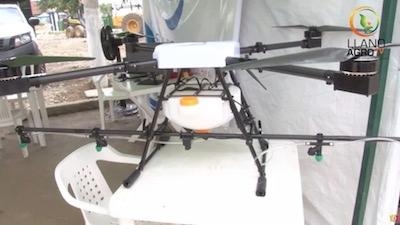Wed, Aug 22, 2018
Ten Drones Being Tested In Nariño Province
The Colombian government is testing a fleet of 10 drones to destroy coca plants that are used in the production of cocaine.

Drone DJ relays a report from the Wall Street Journal which indicates that the new President of Colombia, Iván Duque, prefers using drones over manned aircraft to protect neighboring crops from damage.
The tests are being conducted in the southwestern portion of Nariño province. The drones carry the herbicide Glyphosate, a defoliant, and spray the coca plants with far greater accuracy than could be achieved using more traditional methods. The previous President of Colombia, Juan Manuel Santos, had halted spraying by 14 crop duster airplanes after local farmers filed lawsuits who were concerned about their health. Glyphosate has been linked to some cancers by the World Health Organization.
The U.S. EPA has said that glyphosate is "unlikely" to cause cancer. The chemical has been part of a $10 billion foreign aid package called "Plan Colombia". Use of the chemical reduced the country's coca fields from 470,000 acres in 2001 to 193,000 acres in 2012. But by 2017, the acreage had again increased 160 percent to 516,000 acres.
The drones have been provided by Fumi Drones SAS. German Huertas, director of operations at Fumi Drone says that the aircraft can eliminate about 90 percent of the crops on every acre of coca plants. They also fly lower to the ground, and do not pose a safety hazard to pilots flying close to the ground, Huertas said. The company is also training local police to fly the aircraft.
The downside is that the drones carry a much smaller load of the defoliant than a crop duster, and police must cordon off an area to be sprayed to prevent local farmers from being exposed or cocaine manufacturers from shooting them out of the air. There are also a large number of landmines buried in many regions from a long rebel conflict in Colombia, which can pose additional threats to soldiers and drone pilots.
(Image provided by Llano AgroTV)
More News
Pilot Also Reported That Due To A Fuel Leak, The Auxiliary Fuel Tanks Were Not Used On June 4, 2025, at 13:41 eastern daylight time, a Piper PA-23, N2109P, was substantially damage>[...]
Have A Story That NEEDS To Be Featured On Aero-News? Here’s How To Submit A Story To Our Team Some of the greatest new stories ANN has ever covered have been submitted by our>[...]
From 2023 (YouTube Edition): Reflections on War’s Collective Lessons and Cyclical Nature The exigencies of war ought be colorblind. Inane social-constructs the likes of racis>[...]
Aero Linx: Colorado Pilots Association (CPA) Colorado Pilots Association was incorporated as a Colorado Nonprofit Corporation in 1972. It is a statewide organization with over 700 >[...]
High Speed Taxiway A long radius taxiway designed and provided with lighting or marking to define the path of aircraft, traveling at high speed (up to 60 knots), from the runway ce>[...]
 NTSB Prelim: Piper PA-23
NTSB Prelim: Piper PA-23 ANN FAQ: Submit a News Story!
ANN FAQ: Submit a News Story! Classic Aero-TV: One Mans Vietnam
Classic Aero-TV: One Mans Vietnam ANN's Daily Aero-Linx (07.03.25)
ANN's Daily Aero-Linx (07.03.25) ANN's Daily Aero-Term (07.03.25): High Speed Taxiway
ANN's Daily Aero-Term (07.03.25): High Speed Taxiway



